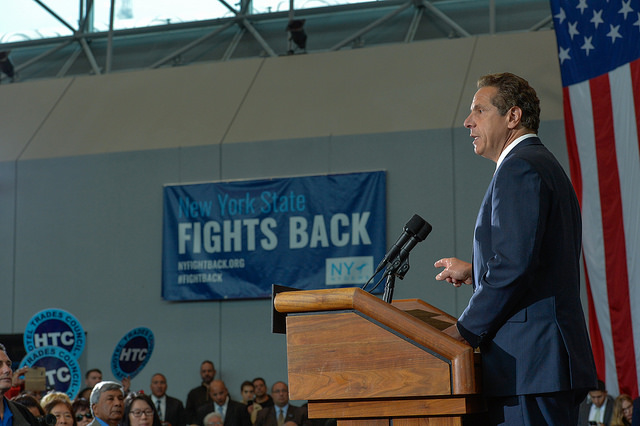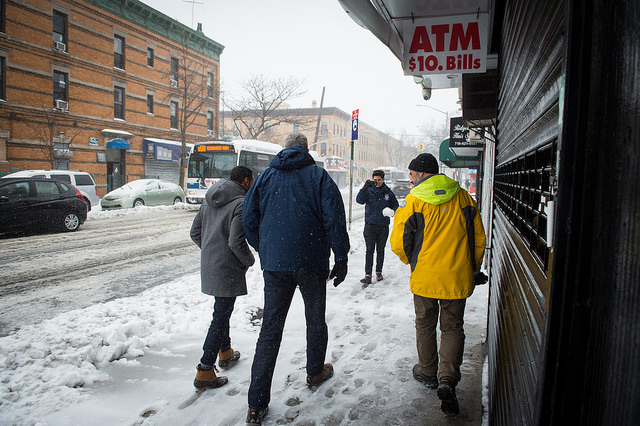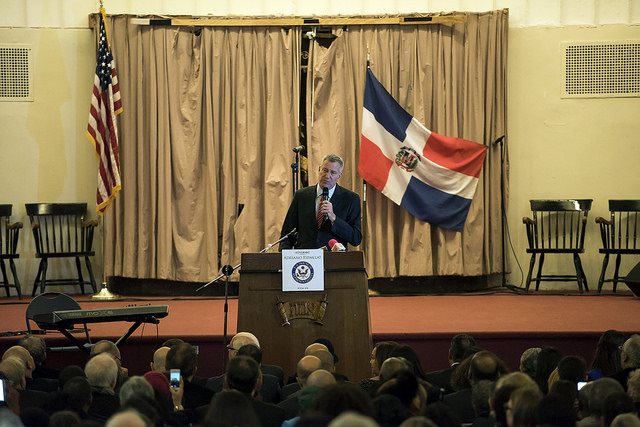For 2018, The Center Must Hold

Gov. Cuomo rallying to flip NY House seats (photo: NY Democratic Party)
If the national Women’s March was any indication, we are in for a Democratic tidal wave come 2018. We’re only seven months into 2017, of course. But if such a wave does occur, then the Republican Party in Congress will only revert back to ideological extremes and obstructionism.
Why? Because the seats up for grabs are largely the 50 seats held by moderate Tuesday Group caucus members. As their influence wanes, the influence of the Freedom Caucus and other extreme conservatives will only grow.
While governing is about compromise, politics is about winning, and having worked on several campaigns in New York, I certainly cannot begrudge Democrats for trying to unseat some of our more moderate Congressional members, as they are the campaign equivalent of low-hanging fruit.
However, in order to govern, the center must hold.
America needs the Tuesday Group. America needs Democratic blue dogs. Congressional Republicans need moderate leaders like Paul Ryan, Kevin McCarthy, Charlie Dent, and Cathy McMorris Rodgers.
Without them, the party in Congress will see a return to turmoil, the likes of which we only briefly glimpsed after John Boehner announced his resignation in September 2015.
Ward Baker, former executive director of the National Republican Senatorial Campaign Committee, wrote a lengthy memo last year to GOP Senate campaigns after it became clear Donald Trump was on track to win the Republican nomination for President. The message of the memo: run your own race.
Tuesday Group members, I cannot stress this enough.
Do not feel beholden to a toxic and unpopular and unpredictable White House. Support the Speaker, cast your vote, but vote your constituents, vote your conscience – not the Saturday morning Twitter spasms of an irrational and unstable Commander-in-Chief.
Reince Priebus and Howard Dean both proved that big tent strategy beats strict ideological adherence every time.
Dean built a 50-state infrastructure that helped Democrats navigate their way to the majority in 2006. Meanwhile, Priebus wrangled FreedomWorks, Americans for Prosperity, Club for Growth, Ending Spending, and other conservative groups to do the same for Republicans in 2010 and 2014.
That’s the reason why my party is now gifted with talented pols like Joni Ernst, Rob Portman, Cory Gardner, Elise Stefanik, John Katko, and Marco Rubio.
In New York, Governor Andrew Cuomo has already declared “war” on Republican House members throughout the state, but based on his track record his bark is worse than his bite. Congressional Reps. John Faso and Claudia Tenney may face strong Democratic challenges, but Cuomo will be too busy padding his own reelection effort to take notice.
Democrats, if they’re interested in winning, need to ditch – and quit praying at the altar of – a Vermont demagogue and remnant of the Old World communist left, who still refuses to even identify as a Democrat, and instead embrace such 21st Century party pragmatists as Cory Booker, Patty Murray, Tom Perez, and John Hickenlooper.
If not, Democrats will only continue to flounder, and suffer more “close but no cigar” moments like Katie McGinty in Pennsylvania, Jason Kander in Missouri, Jon Ossoff in Georgia, and, quite obviously, that glass ceiling-shattering candidate who was supposed to win the White House in 2008 and 2016.
Democrats, I may not be your friend, but I’m certainly not your enemy – Putin and ISIS are the enemy. Your party is in turmoil, you need to figure out what you stand for, and then bring your A-game.
Show Americans you’ve got what it takes to provide jobs, provide roads and bridges, provide health care, education and equal justice, provide prosperity, liberty, safety, security, and the freedom of choice for all.
However, if you can’t do that, if you can’t organize for something other than marching, if you can’t resolve your own petty internecine warfare between intransigent Bernie believers and mainstream party practicables then you deserve to live in the minority until you do.
***
John William Schiffbauer was the Deputy Communications Director for the New York Republican State Committee 2014-16. Last fall, he served as campaign manager for Republican Melinda Crump’s State Senate campaign in New York’s 31st District. On Twitter @jwschiffgop.
***
Have an op-ed idea or submission for Gotham Gazette? Email This email address is being protected from spambots. You need JavaScript enabled to view it.
Did Street Homelessness in New York City Really Just Increase by Nearly 40%?

(photo: Edwin J. Torres/Mayor's Office)
Is the number of people homeless on New York City streets skyrocketing?
There were 3,892 unsheltered homeless people on the streets or outside in public places on the cold night this past February when New York City conducted its annual street homelessness count, according to the City’s own statistics released this month. That’s a jolting 39-plus percent increase in one year over the 2016 street homelessness count of 2,794.
The good news is that many advocates and academics don’t really think there was a 39-plus percent increase in street homelessness in one year. The bad news is that’s because most of them never thought the decreases in street homelessness reported in 2014, 2015 and 2016 were accurate either.
New York City’s HOPE Count (Homeless Outreach Population Estimate) is an annual one-night count of unsheltered people experiencing homelessness on New York City streets, or in public places. The City readily notes it’s really an estimate. It is the point-in-time (PIT) census type count required by the federal Department of Housing and Urban Development from all communities in order to qualify for certain federal funding for homelessness service programs.
These PIT canvasses count both people who are sheltered and unsheltered. In most communities the great majority of people experiencing homelessness are unsheltered. In New York City, though not in any other major city, there is a an enforceable legal “right to shelter” for most people in need, so that the great majority of homeless people in New York City -- more than in any other U.S. community -- are sheltered. The city can provide a completely accurate “daily census” of people in the Department of Homeless Services shelters each and every day. Counting people who are living rough on the streets or in other public places is a very difficult proposition.
Any large scale “count” in a city like New York is a massive undertaking. New York City annually mobilizes between 3,000 and 3,500 volunteers to work with city staff in counting in over 1,500 defined areas, all over one night. They even have a “decoy” program, employing people to be on the streets in the role of unsheltered homeless people over the time of the HOPE count to see how many of the decoys (call them a sort of control group) do or don’t get counted, and use the ratio of counted to uncounted decoys to assist in making the estimate.
These kinds of counts were invented in New York City. Experts have called the New York City effort “the gold standard” of the point-in-time count. This, of course, is not to say the HOPE Count is actually accurate.
There are both unavoidable inherent reasons the accuracy of the count is problematic and problems with the way the count is conducted. To understand the inherent problems, just recognize that this is an effort to count many people who are hiding from view, and many people who do not want to be included in the count.
One of several major problems in the way the count is conducted is that it intentionally limits itself only to counting those on the streets or in public places. But every New Yorker knows many unstably housed people often spend very cold nights in what might be called semi-public enclosed spaces. Think people who hang out overnight in a 24-hour McDonald’s or Dunkin Donuts. And remember, the point in time count is typically scheduled on a January night which tends to be extremely cold. In fact, at least twice in recent years the point in time count was pushed back to the first week in February due to snow storm predictions, but still was held on bitterly cold nights.
For the last several years the Bronx Health and Housing Consortium has conducted their own fascinating count on the very same night as the city’s HOPE Count -- but counted inside in some of the emergency rooms in the Bronx. Consortium President Henie Lustgarten, an organizer of the project that began in 2014, spoke about how the project works.
This volunteer project operating just in a few emergency rooms of hospitals that agreed to participate has developed an ingenuous methodology. In each emergency room they survey they count two groups of people as “homeless.”
First, anyone who registers for emergency treatment indicating they have no address or that they live in a shelter (but wouldn’t be in the DHS census for that night because they aren’t in shelter that night) is counted as homeless.
Second, people who spend the night in the emergency room area but never register to receive medical care are counted as homeless. Lustgarten indicated most of the time this unregistered cohort are sleeping in the waiting room or the emergency room hallways. In recent Consortium emergency room counts those not registered at all account for about half or more than half of their entire emergency room count.
In 2015, for example, surveying just five Bronx emergency rooms, the Bronx Health and Housing Consortium count was 120. The complete HOPE count for the Bronx that year was 69. The numbers and percentages vary, but consistently the Consortium emergency room count has been greater than the HOPE Count of street homeless people in the Bronx.
So the population of unsheltered people experiencing homelessness in New York City probably didn’t increase by 39-plus percent this year. Unfortunately, the real number is almost certainly more than the 3,892 people estimated in the 2017 HOPE Count.
***
Jeff Foreman, who resides in Queens, is Policy and Advocacy Director for nonprofit Care for the Homeless. On Twitter @JeffForeman2 and @CFHNYC.
***
Have an op-ed idea or submission for Gotham Gazette? Email This email address is being protected from spambots. You need JavaScript enabled to view it.
Mayor De Blasio Let Me Down

Mayor de Blasio (photo: Ed Reed/Mayor's Office)
In 2013 I met then-Mayoral candidate Bill de Blasio at a campaign event in midtown. I talked with him about my housing situation, that I had been laid off at work and the rent for my apartment had become too expensive. He said if he was elected, he would do what he could to help people like me. I voted for him.
Soon after our conversation, I lost my apartment. Three years later, I am still homeless. The promises de Blasio made to me seem far away, and now, I’m not sure he is still on our side. Recently he openly criticized panhandlers and questioned whether we are poor enough to ask for money. He’s even said that panhandling “contributes to a decline in quality of life of New Yorkers.” I am a New Yorker - what about my quality of life?
While some things have changed since Mayor de Blasio took office, many others have remained largely the same. Just last week the Mayor published an op-ed about his affordable housing plan. He announced that under his leadership, city government has constructed or preserved nearly 78,000 units of affordable housing, but our homeless population is still hovering around record highs of 60,000-plus.
New buildings are popping up in neighborhoods all over the city and our mayor is celebrating a successful affordable housing plan. So my question for him is, affordable for whom? Most of the units in his plan are for people whose income is much higher than mine, and not enough of it is set aside for homeless people. For me — and the tens of thousands of people like me — the numbers just don’t add up.
Clearly there is not enough housing being prioritized for homeless New Yorkers. And, even the systems that are supposed to help us get housed are full of problems. For the last six months I’ve had the Living in Communities (LINC) rental assistance program – a de Blasio program. If I found a place to live, I could potentially pay the rent with this voucher.
So why am I still homeless? Because landlords across the city are discriminating based on source of income. Landlords and brokers blatantly respond with “no programs,” or “no LINC,” when asked about potential apartments. This is flat-out illegal! While homeless people are getting arrested for jumping turnstiles, landlords are getting away with discrimination against poor people and they’re leaving us out on the street. What good is my LINC voucher if no landlord accepts it?
Everyone -- from city officials to service providers to homeless people -- knows that the subsidies are not keeping up with skyrocketing rents around the city, and the few places that are affordable are often found far away from people’s communities and support networks.
On top of broken rental assistance programs, the city continues to give away public resources that could house more homeless people. Over and over again, we hear about vacant lots, parking lots, or armories being given away to for-profit developers who get city subsidies to build luxury condos and market rate apartments that are often too expensive for the very community members who live there. Public land should be used for public good.
Mayor de Blasio may call me a “skeptic” or a “naysayer,” but before I applaud his housing plan that he says is for everyone, I need to see that homeless New Yorkers are truly included in it.
For the homeless, the solutions are simple: we need the city to make more housing available to us, we need systems in place to help us easily access this housing, we need the city to target bad actors who refuse to rent to homeless people, and we need the city to stop giving away valuable resources to developers who are more concerned about their profits than they are about our communities.
I am homeless not because it is “fun,” but because real estate profits have been put before my needs over and over again.
***
Ruby Carrasquillo is a member of VOCAL-NY, a grassroots organization that builds power among low-income people impacted by homelessness, HIV/AIDS, drug use, and mass incarceration. On Twitter @VOCALNewYork.
***
Have an op-ed idea or submission for Gotham Gazette? Email This email address is being protected from spambots. You need JavaScript enabled to view it.




